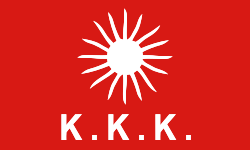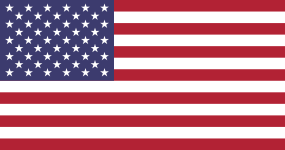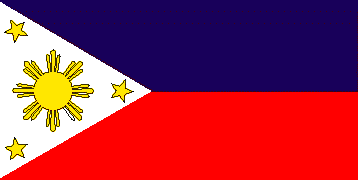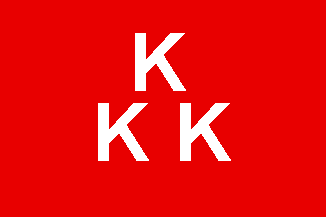Said to be the first official flag of the underground-society-turned-revolutionary government Katipunan (KKK), led by Supreme President Andres Bonifacio y de Castro. The three letter Ks in white centered on a red cloth stood for Kataastasang Kagalanggalangang Katipunan ng Manga Anak nang Bayan (loosely translates into "Most High & Most Sacred Society of the Children of the Land").
An early version of the flag of the Katipunan It has the three (3) white letter Ks arranged in an equilateral triangle on a red cloth. It should be noted that leaders of the KKK had their differing war standards.
 |
| Flown from August 1896 until possibly the Fil-Am War |
 Supposedly the first official revision of the Katipunan flag when military leaders at the 1897 Naic Assembly adopted a design of mythological sun having eight rays but retaining the white-and-red colors.
Supposedly the first official revision of the Katipunan flag when military leaders at the 1897 Naic Assembly adopted a design of mythological sun having eight rays but retaining the white-and-red colors. |
| Flown from 1898 to about 1907; possibly 1919 to about 1936 |
 |
| Flown from about 1904-1907 |
_________
American Colonial Era
 |
| Flown from 1899 (Philippine-American War) - about 1946 |
- The flag of the United States was taught to be the flag of the Filipinos during the American colonial rule. Captured officers of the Philippine Republic and other freedom fighters were made to swear by it. In class, Filipino children were taught the the Bald Eagle flag was their flag. After the imperialist U.S. government tricked Sakay into surrendering and had him executed, it passed the Flag Law of 1907, Act No. 1696, outlawed the display or unfurling of Filipino flags, including that of the Malolos (Philippine) Republic and flags, banners, emblems, and symbols of the KKK. When the flag law was lifted in 1919, the U.S. (Star Spangled) banner was flown side by side with the Philippine flag until 1946.
 | |
| Flown from about 1936* - Present |
According to section 4 of Republic Act No. 8491 issued in 1998, The flag of the Philippines shall be blue, white and red with an eight-rayed golden-yellow sun and three five-pointed stars, as consecrated and honored by the people. Earlier in 1997, the blue in the national flag was changed from navy blue to royal blue, according to Flag Bulletin No. 180. Except for the exact shade of blue, the present flag has retained all specifications found in the 1936 flag decree.
*The Philippine Flag was flown side by side with the American flag from 1936 to 1946 during the U.S.-sponsored Commonwealth government
__________
 Reposts are licensed to the respective authors. Otherwise, posts by Jesusa Bernardo are licensed under Creative Commons Attribution-NonCommercial-ShareAlike 3.0 Philippines.
Reposts are licensed to the respective authors. Otherwise, posts by Jesusa Bernardo are licensed under Creative Commons Attribution-NonCommercial-ShareAlike 3.0 Philippines.

No comments:
Post a Comment